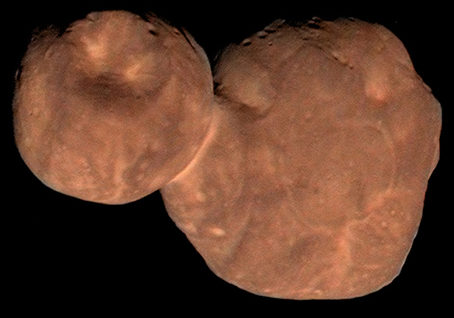New Horizon’s flyby of Arrokoth reveals a pristine object untouched since the solar system’s origin. Its shape and geology show that planetesimals form more gently than previously thought.
Fourteen months have elapsed since New Horizons flew by the Kuiper Belt object named Arrokoth, the most distant world ever visited by a spacecraft – it lies 4.1 billion miles (6.6 billion km, or 44 astronomical units) away from Earth. Now, the spacecraft has returned enough data to Earth for scientists to fully assess what they saw, and they're concluding that our current idea of how planetesimals form is due for an update.
The New Horizons team presented the findings at the annual meeting of the American Association for the Advancement of Science in Seattle and published three papers in the February 13th Science detailing Arrokoth’s formation, geology, and composition.

NASA / JHUAPL / SWRI / Roman Tkachenko
Two years after cruising past Pluto’s orbit and 13 years after leaving Earth, New Horizons reached Arrokoth on January 1, 2019, flying by at 14.43 km/s (30,000 mph) just 3,500 kilometers from its surface. Arrokoth, originally nicknamed Ultima Thule by mission scientists (and technically known as 2014 MU69), turned out to be shaped like a giant peanut: A narrow neck joins two lobes, one slightly larger than the other.
Mission scientists didn’t have a special reason to aim for this object; it was simply at the right location and distance from Pluto to attempt a flyby. But they could have not chosen a better target. New Horizons' proximity enabled the probe to map Arrokoth’s surface with a resolution of 30 meters per pixel. The detail revealed a smooth surface, relatively unmarred by craters. In other words, the surface lacks signs of a violent, collision-filled past.
The observations also confirmed that Arrokoth’s surface is a deep red. “The way the human eye will perceive it is as a very dark brown,” said New Horizons co-investigator Will Grundy (Lowell Observatory) during a press conference. The researchers detected methanol ice on the surface, as well as other complex organic species that the scientists were unable to identify.
Combining the images of Arrokoth with dynamical studies of the Kuiper Belt, the astronomers conclude that Arrokoth formed 4.5 billion years ago. It’s a relic from the early days of the solar system that came together in the outer fringes of the solar nebula. And because of its remote location, it has remained pristine and untouched for most of the solar system’s history.
Peaceful Past

NASA / JHUAPL / SWRI / Roman Tkachenko
Researchers have classified Arrokoth as a contact binary, and new analysis shows it is the product of a gentle collision between two preexisting bodies. It must have been a delicate dance, in which the two objects orbited each other until they came to rest onto each other.
“They are just touching each other, it’s like they are kissing, or if they were spacecraft they would be docking,” said New Horizons co-investigator William McKinnon (Washington University in St. Louis). “There is no evidence that the merger of these two lobes was at all violent.”
The main axes of Arrokoth's two lobes are aligned to within 5°, further supporting the idea of a slow approach under their mutual gravitational influence.
To test this peaceful scenario for Arrokoth’s origin, a group of scientists led by McKinnon ran a series of computer simulations to test various speeds of impact. They concluded that the “impact” must have occurred slower than 3 meters per second. “Probably less than one meter a second, and obliquely, otherwise you cannot explain what we see at Arrokoth,” McKinnon said.
Double Worlds
Binary or contact binary objects seem to be fairly abundant in the Kuiper Belt, according to recent ground-based telescopic surveys. (See Sky & Telescope’s February issue for more on how scientists have come to this conclusion.) The Kuiper Belt is essentially the debris leftover from planet formation. So if Arrokoth came together gently, its example could potentially shift the way scientists think about planet formation in general.
There are two dominant theories for how planetesimals form. The classic hierarchical model posits that a series of collisions gradually grow larger and larger objects, from bits of dust to pebbles to planetesimals, and so on. The main caveat is that this theory has difficulty explaining why the impacting bodies would stick together after colliding rather than ricocheting off each other.
The alternative, and more recently proposed scenario is known as gravitational instability. In this picture, when clouds of small particles within the protoplanetary disk become dense enough, they collapse under their own gravity.
A phenomenon called streaming instability is behind this collapse: Gas in the disk drags on solid particles, so they end up organizing into streams, or strings, of pebble-size particles. Like a line of cyclists riding against the wind, the first pebbles in line receive most of the headwind. The rest of the pebbles drop behind the first ones in order to reduce drag. These pebble strings ultimately collapse directly into objects tens to hundreds of kilometers in diameter on timescales of 1,000 years or less. In other words, massive collapse occurs in the blink of an astronomical eye.
During the press conference, the researchers clarified that the hierarchical model probably still applies later on during the planet-building process, when larger bodies crash into each other and their gravitational pull is strong enough for them to stick together.
“This is a decisive result in favor of one theory: local cloud collapse,” said New Horizons principal investigator Alan Stern (Southwest Research Institute). “I believe this is a game-changer.”
 0
0









Comments
You must be logged in to post a comment.